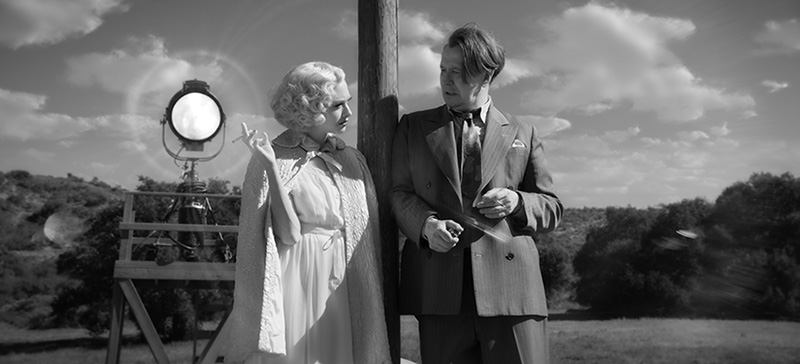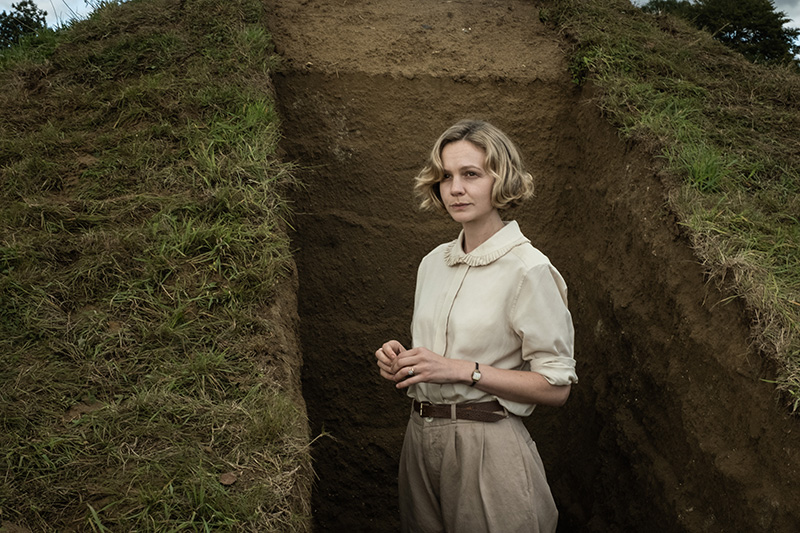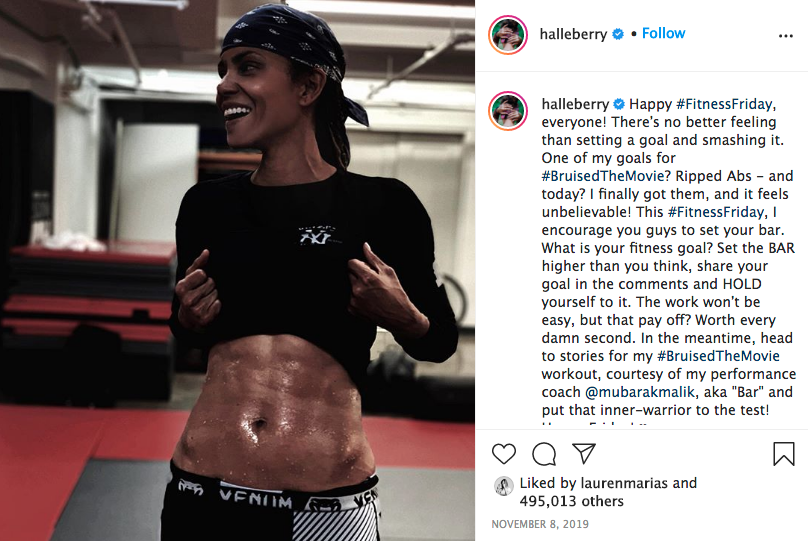‘Mank,’ ‘The Dig’ and Hollywood’s Ongoing Problem With Aging Down Female Characters

Hollywood has a long history of casting younger actresses to play the parts of characters that are meant to be older, or who were older in real life. Above, Amanda Seyfried, 35, plays actress Marion Davies in the film ‘Mank,’ though she’s about a decade younger than the real Davies was at this point in her life. Photo: Courtesy of Netflix
The Netflix original film Mank — a black and white ode to old Hollywood about Citizen Kane screenwriter Herman Mankeiwicz — has proven an award season favourite so far, including earning 10 Oscar nominations this week. Yes, it is a deserving effort, and Gary Oldman brings such depth to the alcoholic scribbler’s life that we begin to root for the character he is playing despite how selfish (and often baldly contemptible) the guy can be.
Part of the softening of the lead character comes from the affections conferred upon him by the women in his life: they are all beautiful, and all young. Young, however, is the issue here.
To start, we have Mank’s long-suffering wife, Sarah. He asks her several times, “Why do you love me?” and we, as viewers, wonder, too. She’s played by Tuppence Middleton, 34, meaning a decade has been shaved off the age of Mank’s real-life wife. Then there is his loyal secretary, Rita, played by the enchanting Lily Collins, 31. Little is known about the real-life Rita, so we can perhaps give the benefit of the doubt that Collins is age appropriate for the role.
But it is the linchpin character of Marion Davies, as played by Amanda Seyfried, 35, (see image above) that poses the real issue. Not that Seyfried isn’t good; she is compelling and nominated for her own Oscar for this role. But the actress is a full decade younger than the real Marion Davies, who was in her mid-40s at the time the film portrays. It’s yet another example of juicy roles for middle-aged women going to younger women who are then aged “up” for the parts.
The Marion Davies character is critical to the emotional tension at the heart of Mank. In real life, Davies became media magnate William Randolph Hearst’s mistress while in her late teens. Already a successful Broadway actress, she transitioned to film stardom through movies produced by Hearst’s Cosmopolitan Pictures production company.
Mank shows how Mankiewicz used Davies’ filial affection for him as his entrée into Hearst’s world, allowing him to take down the eccentric publishing tycoon through his onscreen depiction of Charles Foster Kane. It includes a dramatization of Mank being ostracized from the inner circle at a party at Hearst mansion to which he shows up epically drunk. But that was just the final straw; Mank, a committed socialist, had been increasingly disillusioned by the money-backed right-wing machinations of Hearst, along with Louis B. Mayer. Despite the soft spot he had for Davies, she became collateral damage in Mank’s vendetta to pay back Hearst.

Seyfried, in the role, is glowing with youth and gorgeous: you can see why producers wanted to use that factor to sway the story. And she has noted that she was rehabilitating Davies’ image by giving her a rounding out in this movie. Davies, of course, was skewered in Citizen Kane, as she was universally believed to be as vapid and talentless as Susan Alexander Kane, Charles Foster Kane’s second wife, whom he promoted as an actress in the same manner Hearst promoted (read: bought) the career of Davies in real life.
But in casting younger actresses to play middle-aged women in roles taken from real life, like Mank, is Hollywood not just perpetuating ageism? Romantic leads and meaty parts are notoriously hard for actresses over 40 to find.
Take another Netflix film, The Dig (2020 ) as a second recent example of producers perpetuating the idea that younger women drive plot better through their luminous presence.
Carey Mulligan, 35, stars alongside Ralph Fiennes, 58, in this sweet and small film about an archeological dig in Surrey, England, in the shadow of the Second World War. The story has been telescoped so that the drama of impending war is more pressing in the film than it was in real life (the discovery was actually in 1937, not as RAF planes were training and crashing over the dig site, as they were in the film).
The real life heroine of the film, wealthy widow Edith Pretty, was born in 1893, so she would have been in her late 50s as the dig drama — the discovery of an ancient Anglo-Saxon burial ship in the mysterious hills in her estate — unfolded. Pretty was also in the process of dying of a heart condition (IRL she died in 1942, aged 59) as depicted in the film.

Mulligan, at 35, is a haunting vision in the film, thin and pale and wan and clad in lovely 1930s house dresses and cardigans by day, full finery by night for her formal solo dinners served by butlers in livery. Yet, once again, we have a younger, beautiful actress play the role to serve the story by making her more sympathetic. And while no one is saying that an older actress wouldn’t have been just as beautiful and compelling, it seems a missed opportunity for such a nuanced role to not go to an age-appropriate actress.
Same Old Story
This, of course, is a phenomenon almost as old as Hollywood itself.
Jennifer Lawrence has often been cast in roles of characters older than her years, including in Silver Linings Playbook, where the then-22 year old won an Oscar for playing a 30-something widow and eventual love interest to the character played by Bradley Cooper (who is 16 years older than her). A few short years later, in Joy, Lawrence played the role of the late 30s home-shopping-network star. Scarlett Johansson was just 18 when she was paired up with 52-year-old Bill Murray in Lost in Translation; that character was supposed to be a married-long-enough-to-be-bored college graduate.
In older examples, Barbra Streisand was just 26 when she played the lead — a widowed meddler and matchmaker — in the movie version of Hello Dolly; later stage versions would star more mature actresses such as Carol Channing and Bette Midler. And Sally Field (74) played the mother of Tom Hanks (64) in Forrest Gump; they were aged 48 and 38 at the time.
Moreover, since the earliest silent films, older male leads have been hired to woo much younger women. And we all buy it without protests. Leading men are often 10 to 30 years older than their female leads and/or love interests (looking at you Tom Cruise, George Clooney, Johnny Depp and Denzel Washington as the modern champions of this phenomenon; Clark Gable, Fred Astaire and Humphrey Bogart were the original dashing, but much older, men).
We are weirdly used to accepting that beautiful young women are always interested in hanging out with older men. The presence of bright young things in movies somehow is seen as a surefire way to draw audiences in. But in this particular aspect of make believe, we are perpetuating the idea that older women aren’t appealing enough to play themselves.
There are, however, some actresses actively changing this perception. For instance, Helen Mirren has starred in everything from thrillers to historical dramas — not to mention as a jail-breaking criminal in the Fast & Furious franchise — all since turning 70. And Glenn Close, 73, and Frances McDormand, 63, have proven consistent award-season contenders in recent years.
Meanwhile, Nicole Kidman, 53, has earned laurels — and awards — for her recent starring (and co-producing) roles on hit miniseries’ like Big Little Lies and The Undoing. Halle Berry, at 53, starred, and made her directorial debut, in 2020’s Bruised, for which she also put herself through a punishing training regimen in order to play a disgraced MMA fighter who returns to the cage.

Then there’s Reese Witherspoon and Kerry Washington, both 44, who starred in and produced the hit miniseries Little Fires Everywhere. Witherspoon also co-produced Big Little Lies and, with Jennifer Aniston, 52, created their own award-winning starring vehicle with The Morning Show.
Hopefully this trend of women doing it for themselves will continue so we have more than just the handful of later-life superstars — think the great Meryl Streep — up on awards stages in the coming decades.
Not to mention that it will continue to send the message to Hollywood that age is not something to be hidden, but, rather embraced and used to a film or television show’s advantage.
RELATED:
Jane Fonda at 82: Single and Single-Handedly Still Trying to Change the World
Helen Mirren Turns 75: The Oscar Winner On Her Social Media Appeal and Embracing Your Age